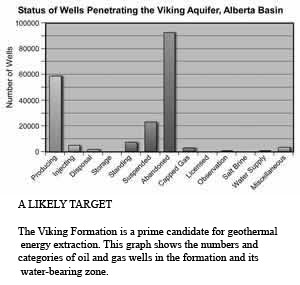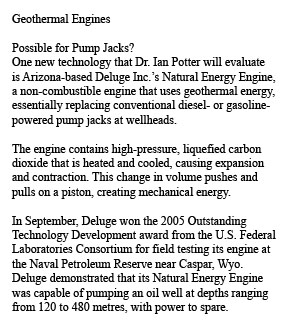Alberta Gets Into Hot Water
 (BY SUSAN R. EATON, P.GEOL., P.GEOPH. PEGG Contributor) - Geothermal technology is improving, oil and gas is becoming less abundant — and researchers are looking seriously at a new resource: water heated by the Earth itself.
(BY SUSAN R. EATON, P.GEOL., P.GEOPH. PEGG Contributor) - Geothermal technology is improving, oil and gas is becoming less abundant — and researchers are looking seriously at a new resource: water heated by the Earth itself. As oil and gas wells approach their final days — and water cuts increase at the expense of the resource — the cost of electricity to produce these marginal wells can become prohibitive. Perhaps there’s a silver lining.
Viewed by many as a liability, the warm water that’s co-produced with oil and gas may be transformed into an asset, extending the commercial lives of stripper wells.
Geothermal waters found in the Western Canadian Sedimentary Basin represent a new form of abundant and cheap energy sequestered in underground aquifers. The renewable energy stored in these subsurface aquifers is sufficient to power geothermal heat pumps and heat exchangers to generate electricity.
The Alberta Geological Survey and the Alberta Research Council have teamed up to study the technical and economic feasibility of harnessing Alberta’s low temperature (10 C to 40 C) to medium temperature (40 C to 140 C) geothermal resources. Preliminary estimates suggest that — given current technologies — the potential energy locked in Alberta’s geothermal waters is two to five trillion barrels of oil equivalent.
An Untapped Endowment
Dr. Rick Richardson, P.Geol., former manager of the Alberta Geological Survey, estimates that even one per cent of the energy contained in the subsurface aquifers could dwarf the remaining oil and gas reserves in the basin.
“We have a huge resource endowment that’s untapped, combined with a huge oil and gas infrastructure,” explains Dr. Richardson, who recently retired and is now consulting to the Alberta Geological Survey. “The Earth is always producing heat and transferring it into aquifers.” The study, he says, will focus on non-potable and saline underground aquifers.
“We’re tying to match the geology to the technology. You can’t just do it anywhere — there has to be an end user with fairly substantial heating and cooling needs.”
At present, there are more than 30,000 heat pump installations in personal residences and commercial facilities across Canada. At Springhill, N.S., heat pumps extract energy from 18 C waters in a flooded coal mine to heat and cool a nearby industrial complex.
Natural Resources Canada’s Office of Energy Efficiency reports that the Springhill geothermal project offsets the need for oil-fired electrical power generation, creating an annual energy savings of $45,000.

It’s Big, It’s Accessible
During the 1980s and 1990s, the Geological Survey of Canada pioneered the study of geothermal resources across Canada, describing the Western Canadian Sedimentary Basin as the largest accessible warm water resource in the country. The GSC says many of the basin’s subsurface geological formations have adequate porosity and permeability to yield both hydrocarbons and warm waters.
Temperatures in the basin correspond with depth, increasing, on average, about 3.3 C for every 100 metres.
Dr. Richardson points to the basin’s large number of abandoned and orphaned wells, considered liabilities by many. “We’re trying to turn oil and gas infrastructure into assets.”
The Viking Formation, one of many prolific oil and gas reservoirs in Alberta, is buried — from east to west — between 1,000 to 3,000 metres. Correspondingly, the Viking’s geothermal aquifers range in temperature from 33 to 99 C.
Dr. Richardson notes that the Viking Formation has been penetrated by 189,000 wells to date — 60,000 of these wells are producing, 100,000 are abandoned and 20,000 suspended.
Historically, the economics of geo-thermal energy projects failed due to the high costs associated with drilling and completing wells. However, much of that work may already be done.
Timing is Critical
“We believe that this project is viable at the moment, but the question is timing,” explains Dr. Ian Potter, Alberta Research Council’s vice-president of energy research. There are many unknowns, says Dr. Potter, including the condition of the province’s boreholes and the replenishment rate of energy (or heat) in subsurface aquifers. “We don’t want to find that we’ve just killed our heat source.”
Dr. Potter’s mandate is to examine technology gaps in geothermal energy extraction and conversion. “We’re taking heat pump technology to the next level. And there’s a role for hybridization of technologies.”
In addition to petroleum producers, other suitable end users for direct-use geothermal energy include hospitals, new housing subdivisions, industrial research parks and municipalities.
“The role of the research council is to showcase the natural resources of the province,” Dr. Potter says. “It’s the start of a new business in Alberta.”
You can return to the main Market News page, or press the Back button on your browser.

